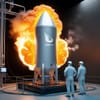Dubai-based tech-driven space innovator LEAP 71 has successfully tested a 3D-printed rocket engine designed entirely by its AI model, Noyron. The engine, made from copper, was designed autonomously without human help and then tested in the UK. The Noyron TKL-5 rocket thruster uses liquid oxygen and kerosene, producing 5 kN of thrust, equivalent to 20,000 horsepower.
The hot-fire test took place at Airborne Engineering's test site in Wescott, UK, where the engine performed perfectly on the first try. It underwent a short-duration test to confirm initial performance and a longer 12-second burn to prove its ability to maintain steady-state operation. Both tests showed the engine's capability to handle the stress and heat of rocket propulsion.
LEAP 71's co-founders, aerospace engineer Josefine Lissner and Lin Kayser, are pioneers in the field of Computational Engineering. According to Lissner, "This is an important milestone for us, but also for the entire industry. We can now automatically create functional rocket thrusters and directly move to practical validation." Kayser added that their company is at the forefront of a new field where sophisticated machines can be designed without manual work, significantly accelerating innovation.
The design of the engine took less than two weeks, a stark contrast to traditional rocket engineering, which can take months or even years. Each new engine iteration takes only minutes to generate using the Noyron AI model. This rapid iteration and testing capability have the potential to make space more accessible by reducing the cost and complexity of rocket engine development.
LEAP 71 collaborated with several partners, including German metal 3D printing company AMCM, which printed the engine on its EOS M290 machine using a copper alloy. The University of Sheffield handled post-processing and preparation for testing. The company is already working with leading aerospace companies in the US, Europe, and Asia to commercialize its rocket engines.


